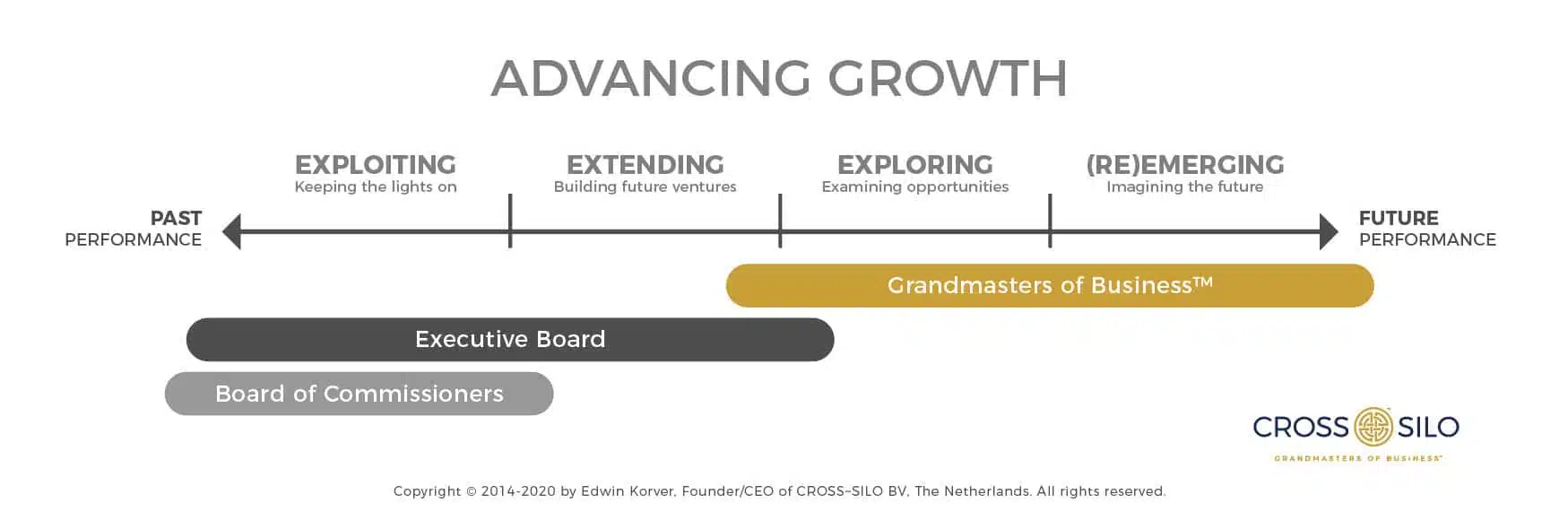In short: The problem with innovation isn’t that people aren’t creative. Most people are. However, very few creative initiatives are worth turning it into an innovation. The challenge is to steer the entire creative process in the right direction and then select the right creative ideas from which to develop viable business ventures. Most executives lack the skills and understanding to steer this creative process effectively. That’s why we’re suggesting a semi-executive role to complement the senior executive in the corporate structure: the Grandmaster of Business™.
Even though we’ve just recently introduced the concept of Grandmaster of Business™ ─ a semi-executive role, with a depth of expertise as well as a breadth of perspective, to drive cross-boundary innovation ─ the characteristics of the role have long been established by many successful business leaders.
Through the Ranks
In their best-seller ‘In Search of Excellence’ (1983), Thomas J. Peters and Robert H. Waterman Jr., two McKinsey consultants, noted that several of the researched companies, such as McDonald’s, Dana, and Delta Airlines, required each new employee to go through the ranks. Even graduates had to start at the bottom of the pyramid, learning the traits of the business first hand.
Business Acumen
In the book, several chief executives had told Peters and Waterman that this hands-on approach helped these employees to develop both insights as well as oversight skills. Or, in the words of Bechtel, it is the obvious path ‘to help them develop a subtle feeling of what is feasible’ while suppressing an, otherwise, obsession for planning, market research, and management systems. Indeed, most successful business leaders have a practical background. Their business acumen didn’t come from business school: they got it from getting their hands dirty and having had real skin in the game. In fact, an effective forward-thinking leader has to be able to master the full spectrum: from business ideas at the highest level of abstraction, down to the smallest, practical details.
Mastership
However, fueled by the idea that each factory needed to achieve the highest level of productivity, specialization soon became the holy grail of business ─ not just on the factory floor but throughout the entire operation. The demand for specialists surged. Business schools and universities, similar to technical education institutions before them, now demand students to choose their specialization early in the program. Students that show a desire to master multiple disciplines, as stated by investor Peter Thiel, are being opposed or even ousted if they are to pursue down a path of becoming a generalist, or so-called polymath.
Interchangeable
However, many of the researched companies that were deemed excellent by McKinsey’s consultants were convinced that the managers and executives had to be interchangeable to be effective. In sharp contrast, very few companies today would even consider swapping their supply chain manager for their sales manager.
Lessons
We’re convinced that the lessons learned from the aforementioned research are as relevant today as they were in the 1980s. Because history repeats itself ─ as taught by the renowned economist Joseph Schumpeter when he described the concept of recurring business cycles. Most technological advancements that were developed during the 60s and 70s have reached their maturity stage and are susceptible to disruption. This process, coined by Schumpeter as creative destruction and reframed by prof. Clayton Christensen as disruptive innovation is both inescapable as well as irreversible. That’s why many refer to this process as a transformation.
Noah Flemming wrote in one of his newsletters: “If you haven’t moved well past reactive mode and aren’t starting to make high impact strategic & tactical plans for how to adapt to this ‘new world order’, then you’re almost at the point where you need to start scrambling.”
Curriculum
Technological change is imminent but behavioral change is slow and cumbersome. It might take years before companies realize that they need to offset the number of specialists with a healthy number of generalists to drive innovation. Similar to how Executive Boards need to balance the number of executives that are risk-seeking versus those that are risk-aversive to allow initiatives to blossom. And it will take even more years before business schools and universities adapt their curriculum to fulfill the demand for creative generalists and business integralists.
Acceleration
Disruption is omnipresent, however, to stimulate creative thinking and accelerate the pace of innovation, companies desperately need more generalists and integralist because ─ as suggested by Harvard’s Heidi Gardners: ‘the vast majority of innovation and business development opportunities [today] lie in the interfaces between functions.’ And what lies between the functions is all but the domain of specialists; it is the domain of generalists and integralists.
That is why we’ve developed an integrated business framework, called the ROUNDMAP™. We’re already training professionals to apply the framework. However, we believe the best way to deploy the framework is by appointing a Grandmaster of Business™ (GoB). This is a seasoned professional that has both the capacity to obtain a breadth of perspective, overseeing the entire business operation, as well as a depth of expertise, providing him/her with a subtle sense of which innovations are most viable, feasible, and desirable. Remember: a mere 1:20 innovations succeed.
Grandmastership
This non-executive role, the Grandmaster of Business™, has to operate both from between as well as across each of the functions, departments, divisions, and stakeholders. His/her primary responsibility isn’t to manage the ongoing business, that’s the role of the CEO. The GoB has to secure the future of the company in a forward-thinking, pioneering role. Compare this to the (mostly) backward-looking, supervisory part, played by the members of the Board of Commissioners.
So, while the Board of Commissioners assesses the company’s current trajectory and the executive team manages the ongoing business, the Grandmaster of Business™ has to develop a revised vision of the future as well as present the scenarios to create that future. To do so, the Grandmaster has to know the limits of the company’s capabilities (techné), knows how to interpret data and other scientific evidence (episteme), while respecting each case from a moral standpoint (phronesis).
We’ll explain more on the role of the Grandmaster of Business™ in the following post.



























